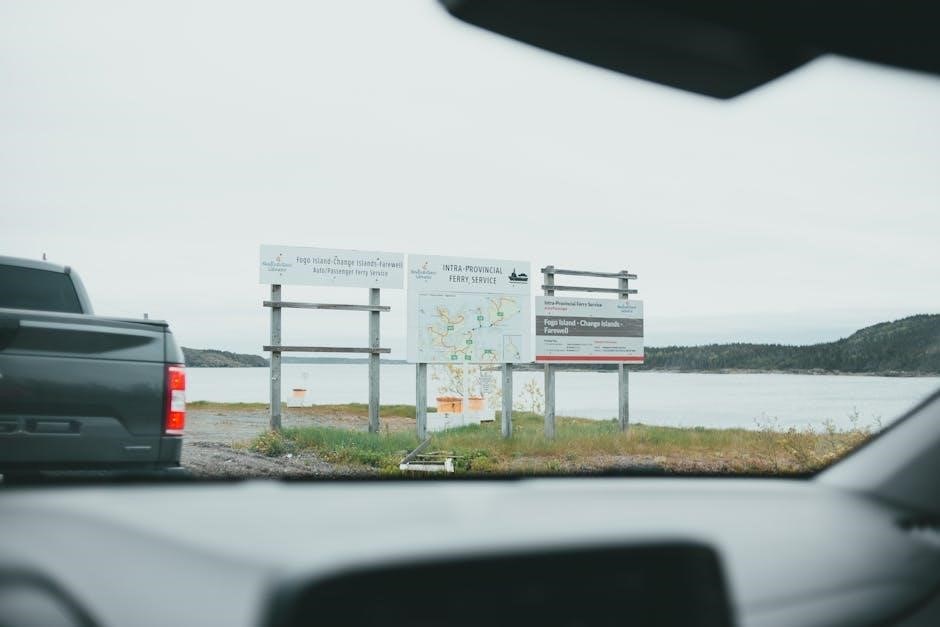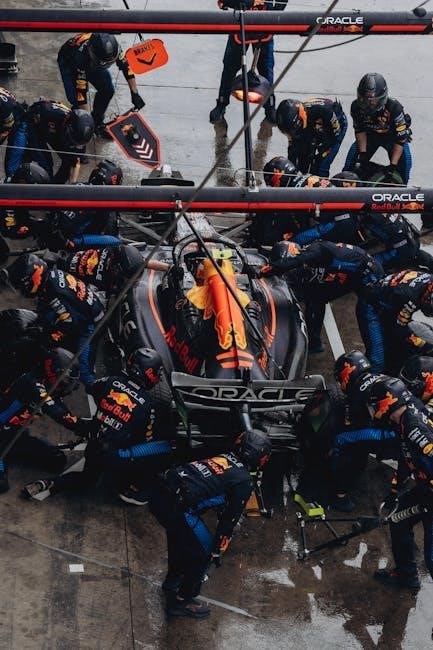
crew change guide
Crew change management is a critical process in maritime operations, ensuring the safe and efficient rotation of seafarers. It involves planning, coordination, and compliance with regulations to maintain vessel operations and crew well-being; Effective crew change management is essential for preventing fatigue, ensuring safety, and adhering to legal requirements. This guide provides a comprehensive overview of the process, challenges, and best practices to optimize crew rotations globally.
1.1 What is Crew Change?
Crew change refers to the process of rotating seafarers on and off a vessel, ensuring continuity of operations while maintaining safety and compliance. It involves replacing fatigued crew members with rested personnel, adhering to legal and operational requirements. This process is vital for preventing crew fatigue, ensuring vessel safety, and upholding maritime regulations. Effective crew changes require precise planning, coordination, and adherence to international and local guidelines to ensure seamless transitions.
1.2 Importance of Crew Change in Maritime Operations
Crew change is essential for maintaining maritime safety, operational efficiency, and crew well-being. It prevents fatigue, ensuring seafarers are rested and alert, which is critical for safe navigation and emergency response. Regular rotations also comply with international labor standards, prevent overstays, and maintain vessel compliance. Additionally, crew changes ensure continuity of operations, allowing vessels to meet schedules and deliver goods without delays, supporting global trade and economic activities effectively.
Crew Change Process Overview
The crew change process involves planning, coordination with port agents, ensuring compliance, and proper documentation. It includes seamless handovers and ensures operational continuity, safety, and efficiency.
2.1 Pre-Crew Change Planning and Preparation
Pre-crew change planning involves scheduling rotations, verifying travel documents, and coordinating with port agents. It requires ensuring compliance with local regulations, health protocols, and visa requirements. Proper preparation includes arranging transportation, accommodations, and COVID-19 testing if needed. Effective planning minimizes delays, ensures smooth transitions, and maintains operational efficiency. It also involves communicated timelines to all stakeholders, including seafarers, agents, and authorities, to avoid last-minute issues.
2.2 Execution of Crew Change
Execution of crew change involves the actual process of seafarers signing off and on, handled by the vessel master, agents, and ship managers. Proper documentation, including sign-off letters and medical fitness certificates, must be completed. Coordination with port authorities ensures compliance with local regulations and health screenings. Efficient execution minimizes delays, ensuring smooth transitions while maintaining safety and operational continuity. Clear communication between all parties is essential for a seamless process.
2.3 Documentation and Compliance
Documentation and compliance are critical in crew change management. Accurate records, including sign-off letters, medical certificates, and immigration documents, must be maintained. Compliance with international regulations, such as those set by the IMO, and local port requirements is essential. Proper documentation ensures smooth processing with authorities, reduces legal risks, and facilitates seamless crew transitions. Digital platforms can streamline document verification, ensuring all requirements are met efficiently and transparently.

Challenges in Crew Change Management
Crew change management faces complex challenges, including logistical coordination, regulatory compliance, and external disruptions like pandemics. These factors require meticulous planning and adaptability to ensure smooth operations.
3.1 Logistical Challenges
Logistical challenges in crew change management involve coordinating travel arrangements, accommodating time zones, and managing resource availability across different regions. These complexities are compounded by varying port restrictions, visa requirements, and limited transportation options, particularly during global crises like COVID-19. Ensuring timely and cost-effective crew rotations while maintaining compliance with local regulations adds significant layers of difficulty to the process.
3.2 Regulatory and Compliance Hurdles
Regulatory and compliance hurdles significantly impact crew change management, as maritime operations must adhere to diverse international and local laws. Requirements such as mandatory COVID-19 testing, quarantine protocols, and specific visa regulations vary by port and country, creating complexity. Additionally, documentation processes, including approval from authorities like the DG Shipping, must be meticulously managed to avoid legal issues and ensure smooth crew rotations, further complicating the overall process.
3.3 Impact of Global Events (e.g., COVID-19)
Global events like the COVID-19 pandemic have profoundly disrupted crew change processes, introducing unprecedented challenges. Travel restrictions, mandatory testing, and quarantine requirements have delayed rotations, exacerbating crew fatigue. Seafarers were often denied priority access to vaccines, further complicating their ability to join or leave vessels. These disruptions underscored the need for adaptive strategies to maintain crew welfare and operational continuity during crises, highlighting the vulnerability of maritime operations to external shocks. Crew managers faced significant logistical and regulatory hurdles as a result.
Best Practices for Efficient Crew Changes
Effective planning, clear communication, and compliance with regulations are key to efficient crew changes. Coordination with port agents, use of technology, and prioritizing crew welfare ensure smooth operations.
4.1 Coordination with Port Agents and Authorities
Collaboration with port agents and local authorities is crucial for seamless crew changes. Agents handle logistics, including visa arrangements, customs clearance, and transportation, ensuring compliance with port regulations. Effective communication ensures all stakeholders are informed, reducing delays. Regular updates and adherence to local rules help avoid bottlenecks, making the process efficient and stress-free for both crew and management.
4.2 Utilizing Technology for Streamlined Processes
Technology plays a pivotal role in streamlining crew change processes. Digital platforms enable real-time tracking of crew rotations, while automated systems handle documentation and compliance. Tools like maritime management software optimize planning, reduce paperwork, and enhance transparency. Mobile apps facilitate communication between stakeholders, ensuring seamless coordination. Technology not only improves efficiency but also minimizes errors, making crew changes faster and more reliable for all parties involved.
4.3 Ensuring Crew Welfare and Safety
Ensuring crew welfare and safety is paramount during crew changes. This involves adherence to safety protocols, provision of necessary safety gear, and addressing mental health. Regular health screenings and COVID-19 tests are essential. Crew members must be provided with safe transportation and accommodation. Access to counseling services and emergency response plans further enhances safety. Prioritizing welfare ensures a smooth transition and maintains crew morale, which is critical for operational success and compliance with maritime standards.

Legal and Regulatory Considerations
Legal and regulatory considerations are crucial for crew changes, involving compliance with international laws, such as IMO guidelines, and local port regulations. Visa requirements, health protocols, and documentation are key to ensure smooth crew transitions and avoid legal issues.
5.1 International Maritime Organization (IMO) Guidelines
The International Maritime Organization (IMO) provides guidelines to standardize crew change practices globally. These guidelines ensure compliance with safety, health, and environmental regulations, promoting smooth crew rotations. They address documentation, training, and welfare, while also considering emergency situations like pandemics. Adherence to IMO guidelines helps maintain operational efficiency and legal compliance, safeguarding both crew and vessel operations worldwide.
5.2 Local Port Regulations and Restrictions
Local port regulations vary globally, influencing crew change processes. These rules may include specific documentation requirements, customs procedures, and health screenings. Restrictions often arise from national laws, port authority mandates, or emergency measures like COVID-19 protocols. Compliance with local regulations is crucial to avoid delays or penalties. Crew managers must coordinate with port agents to navigate these requirements effectively, ensuring seamless crew rotations while adhering to regional laws and guidelines.
5.4 Visa and Travel Requirements
Visa and travel requirements play a pivotal role in crew change processes. Seafarers must comply with destination country laws, securing necessary visas and permits. Documentation, such as passports and medical certificates, must be up-to-date. Travel restrictions, including COVID-19 testing and quarantine rules, can complicate crew rotations. Coordinating with port agents and authorities ensures compliance, while advance planning helps mitigate delays. Adhering to these requirements is essential for smooth crew transitions and legal adherence.
Crew Change in Different Regions
Crew change processes vary significantly across European, Asian, and American ports due to differing regulations, logistical demands, and regional compliance requirements. Each region presents unique challenges.
6.1 Crew Change in European Ports
Crew changes in European ports are complex due to diverse regulations and logistical demands. Each country may have specific requirements, making coordination with local agents crucial. Compliance with EU and EASA guidelines is essential. Additionally, ports in Europe often require advanced planning for visa management and travel arrangements. COVID-19 protocols and sustainability practices further influence crew change processes. Effective communication and adherence to regional rules ensure smooth operations in European jurisdictions.
6.2 Crew Change in Asian Ports
Crew changes in Asian ports are complex due to the region’s busy maritime traffic and diverse regulatory requirements. Challenges include coordinating with multiple authorities, navigating varying national regulations, and managing logistical constraints. COVID-19 restrictions have added layers of complexity, requiring meticulous planning. Port agents play a crucial role in facilitating smooth transitions. Technological tools and real-time monitoring are increasingly used to enhance efficiency and compliance with local and international standards in these dynamic environments.
6.3 Crew Change in American Ports
Crew changes in American ports are critical for maritime operations, ensuring seafarers are well-rested and vessels remain operational. The process involves strict adherence to U.S. visa and travel regulations, along with COVID-19 protocols. Port agents play a key role in facilitating smooth transitions, while technology helps streamline logistics. Compliance with local and international laws is essential, making coordination between stakeholders like port authorities and customs crucial for efficient crew rotations in this region.
Role of Technology in Modern Crew Management
Technology is revolutionizing crew management through digital platforms, real-time monitoring, and automated compliance tools, enhancing efficiency and ensuring seamless operations in modern maritime environments.
7.1 Digital Platforms for Crew Planning
Digital platforms streamline crew planning by centralizing data, automating schedules, and enabling real-time collaboration. These tools optimize rotations, ensure compliance, and enhance communication between stakeholders, improving overall efficiency and reducing operational delays in maritime crew management systems globally.
7.2 Real-Time Monitoring and Reporting Tools
Real-time monitoring and reporting tools provide live updates on crew change status, enabling proactive decision-making. These systems track crew rotations, document compliance, and generate detailed reports, ensuring transparency and accountability. Advanced tools offer dashboards for overseeing multiple vessels, managing deadlines, and addressing discrepancies promptly. This technology enhances operational efficiency, reduces delays, and ensures seamless communication between stakeholders, making crew change management more reliable and data-driven.
7.3 Automated Systems for Compliance Tracking
Automated systems streamline compliance tracking by monitoring regulatory requirements and ensuring adherence during crew changes. These tools integrate with management software to track certifications, visas, and health protocols, reducing manual errors. Real-time alerts notify managers of upcoming deadlines or documentation gaps, ensuring seamless compliance with international and local regulations. Automated reports further simplify audits and demonstrate adherence to standards like IMO guidelines, making compliance tracking efficient and reliable.
Post-Crew Change Procedures
Post-crew change procedures involve finalizing handovers, updating documentation, and evaluating the effectiveness and efficiency of the crew rotation process.
8.1 Handover Processes
Handover processes ensure a smooth transition between outgoing and incoming crew members. This involves transferring critical documents, briefing on vessel status, and updating operational logs. Thorough handovers prevent operational disruptions and maintain continuity. Both parties must sign off, confirming the transfer of responsibilities. Clear communication and detailed documentation are essential to avoid misunderstandings. Proper handovers safeguard the vessel’s safety and operational efficiency during crew changes.
8.2 Reporting and Feedback Mechanisms
Reporting and feedback mechanisms are essential for transparency and continuous improvement in crew change processes. Detailed reports are generated by crew managers, documenting the entire process, challenges faced, and outcomes achieved. These reports are shared with stakeholders, including ship owners and port authorities, to ensure accountability and compliance. Feedback is also collected from crew members to identify areas for improvement, enhancing the efficiency and effectiveness of future crew changes.
8.3 Evaluation of Crew Change Efficiency
Evaluating crew change efficiency involves assessing key performance indicators such as time taken, delays, compliance with regulations, and costs incurred. This process ensures that crew rotations are executed smoothly and effectively. Feedback from crew members, port agents, and ship managers is analyzed to identify bottlenecks and areas for improvement. Regular evaluation helps optimize crew change processes, reduce operational disruptions, and enhance overall maritime operations. Continuous monitoring ensures adherence to best practices and regulatory standards.

Training and Development for Crew Managers
Training and development for crew managers are essential for mastering crew change processes, ensuring compliance, and enhancing operational efficiency. Continuous learning helps managers adapt to industry changes.
9.1 Essential Skills for Crew Managers
Crew managers require strong organizational, communication, and problem-solving skills to handle complex crew rotations. Proficiency in maritime regulations, attention to detail, and ability to work under pressure are crucial. Leadership skills ensure effective team coordination, while knowledge of logistics and compliance facilitates smooth operations. Time management and adaptability are vital for addressing unexpected challenges. These skills collectively ensure efficient, safe, and compliant crew change processes.
9.2 Training Programs for Effective Crew Management
Training programs for crew managers focus on enhancing skills in crew planning, compliance, and logistics. These programs cover regulatory requirements, effective communication, and conflict resolution. Hands-on exercises and case studies help managers navigate complex scenarios. Training also emphasizes the importance of crew welfare and safety. By equipping managers with practical knowledge and tools, these programs improve efficiency, reduce errors, and ensure smooth crew rotations. Regular updates on industry trends are also included.
9.3 Continuous Learning and Professional Development
Continuous learning and professional development are vital for crew managers to stay updated on industry trends and best practices. Regular workshops, webinars, and certifications ensure managers are proficient in handling complex crew changes. Professional development programs focus on improving decision-making, problem-solving, and leadership skills. Staying informed about regulatory changes and technological advancements ensures compliance and efficiency. Encouraging lifelong learning fosters a culture of excellence and adaptability in crew management.

Future Trends in Crew Change Management
Future trends include automation, AI integration, and global standardization, enhancing efficiency and compliance in crew change processes while addressing sustainability and technological advancements in maritime operations.
10.1 Automation and AI in Crew Management
Automation and AI are revolutionizing crew management by streamlining tasks such as scheduling, compliance tracking, and document verification. AI-powered systems analyze data to optimize crew rotations, reduce errors, and improve decision-making. Automated platforms also enhance communication between stakeholders, ensuring seamless coordination. These technologies not only save time but also improve crew welfare by predicting fatigue risks and ensuring adherence to safety standards, making maritime operations more efficient and sustainable.
10.2 Sustainability Practices in Crew Change
Sustainability in crew change involves reducing environmental impact through optimized logistics and eco-friendly practices. This includes minimizing fuel consumption during crew rotations, reducing travel needs, and adopting digital tools to lower carbon footprints. Sustainable practices also focus on waste reduction and promoting eco-conscious operations. By aligning crew management with environmental goals, the maritime industry can achieve greener and more responsible crew change processes while maintaining operational efficiency and compliance with global standards.
10.3 Global Standardization of Processes
Global standardization of crew change processes aims to unify procedures across regions, reducing complexity and improving efficiency. Standardized protocols ensure compliance with international regulations, simplify logistics, and enhance consistency. By adopting universal guidelines, the maritime industry can address varying port requirements and minimize delays. Standardization also promotes transparency and reduces errors, facilitating smoother crew rotations worldwide. It enables better coordination between stakeholders and supports the seamless implementation of technological advancements in crew management systems.